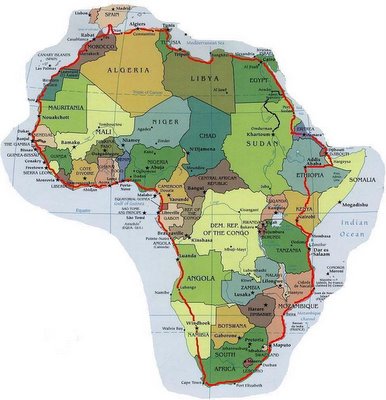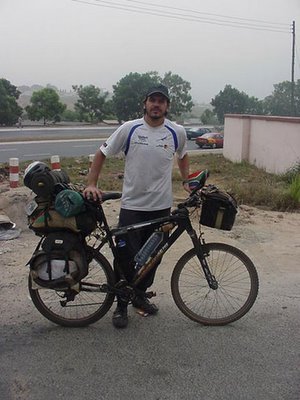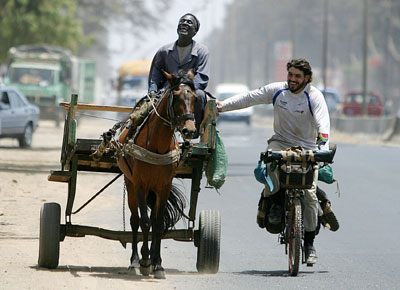What Woodward wrote is so true, people tend to be unexpectedly nice--even kind--when you are cycling.
A bicycle built for seeing AmericaWriter takes cross-country trip on two wheels
By Calvin Woodward
Associated Press
NEWPORT BEACH, California (AP) -- When you bicycle across the country, people tell you their dreams, because they see you are living yours.
"I've always wanted to ..." they say. "Someday, I'll ..."
They speak of physical challenges to conquer or exercises of the mind. Of going places or doing more at home. Some dreams already are in motion; others may never fly.
People are surprised to find themselves talking about whatever mountain it is they want to climb. Something about someone inching from one side of the country to the next brings it out of them.
Craig Pattison, for example.
He clears trees for a living. Last year, he had a little music festival on his western Missouri hilltop. The rains washed the festival out and he took a financial bath. This year he almost broke even.
His words escape from a bushy beard as he speaks of his dream. "I've always wanted to have Willie Nelson play in my backyard."
Waitresses talk about not being waitresses someday. A teenage girl in small-town Kansas, minding her little brother in a park, notices the bicycle with all the bags and offers with curious eyes and a voice as even as the prairie, "I've never been anywhere."
Crossing the country at 12 mph to 15 mph, loaded down, takes about three months. It's hard. This is an enormous country. Who knew?
One astonishing thing about this trip is that it can be done at all in this day and age.
In this land of congested suburbs, clogged highways and city clatter, it's possible to go from Washington, D.C., to the Pacific on roads less traveled.
The route is stitched together from lonely backroads and byways, bordered by farms and meadows. The silence is often vast, broken only by the wail and thunder of the freight train, still the signature sound of America.
You study every house, examine individual weeds for longer than they are worth.
In the rain or under a blistering sun, you think of this equation too often -- one hour in a car would take you as far as one whole day on a bicycle -- 60 to 70 miles. One day in a car covers as much ground as a week on a bike. It can all seem so absurd.
But then there are places like Union County, Kentucky, endless fields of rich-green soybeans.
And the canopy of leaves over the Katy Trail, an off-road path meandering hundreds of miles along the Missouri River and west, in the footsteps of Lewis and Clark.
And the payoff vista after 2,000 miles of traversing east to west -- the opening act of the Rockies rising in the distance from the Colorado flat country.
The journey reveals a country in subtle transition. Combines still reap the harvest but GPS systems now guide some of them, satellites steering them precisely down rows.
Little towns are starting to live on the flush side of the digital divide, installing wireless antennas atop grain elevators and using high-speed Internet to snag business and connect citizens to the outside world.
Trade as well as technology reshapes the heartland. Trains still snake across the landscape but many of the freight cars carry the names of Chinese companies sending goods from across the Pacific.
And waves of Hispanic or Asian immigration reach deep into places where neighbors have known neighbors for generations, except when they left for a better life.
More than the beauty of the land, the openness of strangers impresses the transcontinental bicyclist. Police officers escort you to the town park for a free night of camping. People take you in, feed you and give you water. They save you from heat stroke and worry that the headless horsemen of Appalachian lore and the Skin Walkers, evil spirits of the southwestern desert, will get you.
"Take my truck," Carla Weatherly pleads, serving coffee at the Main Book Co. bookstore and coffeehouse in Cortez, Colo. "Drive to Flagstaff and leave it there somewhere safe. I'll come get it."
She had just told a stranger to drive her pickup five hours into Arizona and somehow she would retrieve it someday. She did not want to see me going through the heat, isolation and ghostly dangers of the Indian lands.
Her offer was so generous it had to be refused. But America is full of people like Carla.
It's full of dreamers, too.
Virginia Calvin Woodward's bicycle parked by the side of a Virginia road.
Calvin Woodward's bicycle parked by the side of a Virginia road.People bicycling cross-country have many choices but the TransAmerica Trail is the mother road. It dates to 1976, when a group called BikeCentennial, now the Adventure Cycling Association, celebrated the nation's 200th birthday by laying out the 4,248-mile route between Astoria, Oregon, and Yorktown, Virginia.
I began in Washington, negotiating the heavy traffic of northern Virginia and joining the TransAm in Charlottesville.
Virginia is some 400 miles long when riding diagonally to its southwest corner, with much climbing. Adventure Cycling says the Appalachians, although dwarfed by the Rockies, are harder to cross because of day upon day of steep grades. Fields of wildflowers are one reward for the work.
* * * * *
 Woodward passes a decaying old house near Charlottesville, Virginia.
Woodward passes a decaying old house near Charlottesville, Virginia.In Marion, Virginia, Mark Prater works from 5 a.m. to 11 p.m. every day on his dream -- an Exxon station and convenience store he built on the site of a razed gas station run by his late grandfather for 45 years. Every item is in place. The lighting is warm. A hand-painted mural testifying to the area's railroad roots spreads across the back wall.
Prater shows his visitor how to ring beer. He breaks open cases of 24 and divides them into six packs or 12 packs. He stretches the rings on plastic sleeves over the cans, one at a time, making sure every label faces out. He's fast.
For all that work, he makes an extra 24 cents on six cans of beer by breaking down the cases into smaller units. He figured he'd made $400 by ringing beer since opening his station six months earlier. Every quarter helps. He competes with the Citgo station across the street.
His secret weapon: cheap gasoline that was still in the tanks from his grandfather's operation six months earlier. He survived an opening-round price war that way. His wife, Joanie, joins him in the evenings after her day job.
KentuckyDogs and hills are the challenge of Kentucky. Coal trucks on narrow roads, too. Here begin the fields of soybeans that dominate the verdant farmscape for 1,000 miles.
A scream, "Get outta here," makes the dogs turn tail and run. Good thing, because they chased this bicyclist at the rate of a half dozen a day, only in Kentucky. Others use pepper spray.
Norvill Jones, who has biked across country three times and in every contiguous state in his retirement, swears by a big stick. When a pack comes after you, he says, whack the lead dog on the head and they'll all run off.
* * * * *
Mary Hale answers the door, a touch suspicious. The day is roasting. Heat shimmers off the new blacktop on a steep road deep in the hills and hollows. Dizziness, nausea and shivers signal that I have heat exhaustion.
From the porch of her hilltop home, Mary offers ice water and explains her nervousness about seeing a stranger at her door. Her house has been broken into three times. Recently she caught a man trying to go in through a window. All Christmas presents were stolen one year.
Matronly in her long dress and white hair in a bun, she invites me in, makes me a ham sandwich, shows a picture of the house as it was when she and her husband, Mike, bought it. It was falling apart. Now it's like new. They did all the work themselves, and it's still a work in progress. The backyard looks down steeply on tobacco fields.
A thunderstorm gathers and we sit on her front porch watching it sweep by. She shrugs off an apology for interrupting her day. "I was just downloading gospel songs on Yahoo," she says.
At a convenience store miles down the road, a man in a pickup truck pulls up. "I'm Mary's husband," he says. "She sent me to see if you're OK and need a drive anywhere."
Norvill Jones, that veteran of dogs and mountains, had told me: "Never be too proud to hitch a ride up a hill." Mike drives me the last miles to the nearest town.
At Whitesville, Kentucky, near the Indiana line, the terrain abruptly changes. The rollercoaster hills turn gentle. Union County, the last chunk of Kentucky before the Ohio River, is spectacular.
Soybeans and corn everywhere. A farmer pulls up in a pickup, then a neighbor pulls up in his truck on the other side of the road. I stand on the yellow line between them. "I don't like to travel," the farmer says. "I like to know where the sun comes up and where it goes down every day."
MissouriAn easy two days across southern Illinois brings me to the Mississippi River, riding on levee roads in the state's western section that are so quiet, three hours go by without a car passing. The question arises: Where on earth have the 298 million Americans gone?
Adventure Cycling publishes authoritative maps of the TransAm and other routes, laying out terrain, history, quirks and services of each section. This is vital information when biking many miles between sources of water, food and shelter. On the banks of the Mississippi, the course ahead looks daunting -- the Ozarks, more "nickel and dime hills so overpopulated with snarling dogs," as a friend warns me. Enough.
I go 70 miles north to the Katy Trail on the outskirts of St. Louis. The nation's longest rail-to-trail route, at 225 miles, it demands no steeper climbing than the trains of past centuries could manage. The limestone path turns the bicycle white; much of the four-day leg snakes between the Missouri River and steep bluffs.
Katy gets its name from the old Missouri-Kansas-Texas Railroad, or M-K-T, and tiny towns along the way are named after railroad executives. One exception is Mokane, Missouri, drawn from the initials for Missouri, Kansas and Nebraska.
A passing biker discloses his strategy for showering after camping in town parks; he ducks into self-serve car washes and hoses himself down at high pressure. No word on whether he springs for the wax finish.
On a particularly remote stretch, a too-large feline figure occupies the center of the trail ahead. It walks in a circle, sits and stares. The "get outta here" yell seems inappropriate. I turn tail and find a path leading to a gravel road and a long looping detour into the nearest community, where people confirm sightings of mountain lions. The big cat was probably heading to the nearby sheep farm for lunch, they say.
The only reasonably direct way into Kansas from the end of the Katy Trail in Clinton, Missouri, is by Highway 7. It isn't pleasant.
Busy and hilly and, worst of all, no services for many miles. I finally come to a convenience store late in the day, with 30 miles to go to the nearest town.
* * * * *
Craig Pattison, 56, pulls up in his pickup. Burly, rough-edged, a braid halfway down his back -- I don't know what to make of him. He invites me to camp at his place on the hill.
It's a great old farmhouse on 63 acres, bought for $160,000 not many years ago. A natural bowl in the earth serves as the amphitheater for his music festival. He's got fancy "hippie chickens" and various gardens, including a patch where he and his wife defy the climate and grow bananas. His daughter Tess has the Internet savvy to help market the festival then two weeks away.
Pattison makes his living as founder of Beaver Stump & Tree. When big hurricanes come hundreds of miles away, he packs up his crew and drives into their path, and has much business for weeks.
He cooks steaks for us. He dotes on his wife, Christy, a truckstop waitress, and stays up past his usual 8 p.m. bedtime for several hours until she gets home. She walks in to soft music and candles.
In the morning, he takes me to breakfast at Christy's restaurant. I tell him he should run for mayor. He points out there is no town to be mayor of.
KansasPeople of the High Plains ought to have as many words for wind as the Inuit have for snow.
It rules. It fools with you all day. At your back, it makes you sail. Coming at you, it's like swimming upstream in molasses. Mostly it comes at me, out of the southwest.
The trees thin out rapidly after eastern Kansas, yielding to the otherworldly beauty of rolling grasslands. There and in the arid western Plains, services of any kind become infrequent. Hot howling headwinds slow progress to 7 mph. Temperatures are over 100 for days at a time, hitting 109 on a bank sign.
 A distinctive building in Ellsworth, Kansas, cries out for renovation.
A distinctive building in Ellsworth, Kansas, cries out for renovation.Brown fields after the harvest kick up waves of dirt that stream across the road. Tumbleweed skitters. The occasional stack of hay bales offers the only sliver of shade to be found for five miles, 10 miles, 20 miles.
Then there are the locusts, three swarms of them, each coating the pavement for two or three miles.
They jump waist-high when you come upon them, the ones you don't crunch. When a cattle truck passes, bringing its own hot wind, they rise in a cloud, hit your face.
This is a land without adornment.
Even the rare gas station is unmanned and self-serve, like an ATM machine with nozzles -- pay, pump, go.
No Big Gulps here.
On Route 96, there are always grain elevators on the horizon, ghostly white towers you can see 10 miles away. Some have soda machines. You pray they don't eat your change.
A friend puts it best: "Kansas is purgatory rolled flat."
Yet, other bikers, experiencing favorable winds and cooler days, count Kansas among their favorite states.
You can sense the mountains now, days before you see them. The pancake flatlands have a subtle upward tilt you wouldn't notice in a car. And when you do go up a mild hill now, you don't go down.
A 35-mile leg south to Garden City from Scott City brings the trip's second encounter with heat exhaustion. Water in the bottles is hot, a passing relief only when I spray it on my head and the wind turns it briefly cool as it evaporates. I have the chills in 105-degree heat. I pass few houses, but stop at two for cold water.
I am riding past feedlots, dirt yards with troughs where cattle fatten by the tens of thousands for slaughter.
Gone is their curiosity back in the grasslands, where they all looked up at the passing bicyclist. Now they are dull-eyed.
ColoradoColorado offers many features not encountered since the East. Among them: coffee chains, suburban sprawl, wide shoulders and Democrats.
I'm again on the TransAmerica but only for a short distance. After Pueblo, the TransAm veers toward the Pacific Northwest. Running short on time, I'm now heading toward San Francisco on the "Western Express," hundreds of miles shorter than the TransAm but with extremely remote desert stretches ahead through Utah and Nevada.
Instead of the short, steep ups and downs and switchbacks of Appalachia, the Rockies call for hours of climbing at a time on roads that are generally more gently graded than in the East. Then come exhilarating descents, some as long as 20 miles.
It soon becomes evident even San Francisco will be out of reach in the few weeks left before I'm due back in Washington. Time to head to southwestern Colorado and figure out a route to Los Angeles, now the best bet for making tracks to the beach.
* * * * *
I am not a soldier home from the wars, nor a refugee from hurricanes. Instead, I'm in a pickle of my own making.
It doesn't matter. People throughout the East and the Plains go out of their way to help in every pinch.
When a motel was full in Kentucky, the proprietors opened a spare room in their house.
When the only store at an Illinois crossroads was closed that night, the owner reopened and piled on free food and drink.
In Ness City, Kansas, a band of young men who had moved back after college to try to save their town put me up, invited me for barbecue, showed me the skyline from atop a grain elevator and took me to meet the mayor.
But only in Colorado does a lady give me her husband's pants.
After a 3 1/2 hour climb to Lizard Head Pass, elevation 10,222 feet, I ride into black clouds and a hard, bone-chilling rain. I wheel numbly into Rico, a largely boarded up town of some 200 people, and stand dripping at the door of a tiny cafe.
"Here, give me your sleeping bag, I'll put it in the dryer," Brandi the waitress demands.
Inside, the jazz quintet Rico Blues Project plays. Brandi wants to dry my pants, too, but I have none to change into. Cheryl Wiescamp, wife of the guitar player, fetches her husband's spare jeans from their van.
"Take them," she says. "It's going to get colder. I've got some sweaters too. Do you need a tent? We've got a tent."
Warmed, dried, revived, I leave, Jeff playing his riffs and never looking up as his pants walk out the door.
"He is very zoned when he plays," Cheryl wrote later. "After the gig I told him I gave away his clothes and he said, 'Good, I needed some karma.' "
After offering her truck and a place to stay down the road in Cortez, Carla Weatherly explained why she and her husband, Warren, had been moved to help me that day in August. It had something to do with their own dreams.
"We are two souls with a wanderlust and love hearing about others who are free to travel," she said. "You would think we were settlers hungry to hear of outside news."
She wrote in December to say Warren was killed in a workplace accident. Police said a frozen rock mixture fell on him while he was doing road work at Durango Mountain Resort.
 Carla Weatherly and Patrick Slover of the Main Book Co. bookstore and coffeehouse in Colorado.Arizona, California
Carla Weatherly and Patrick Slover of the Main Book Co. bookstore and coffeehouse in Colorado.Arizona, CaliforniaIn Flagstaff, I meet Ivan from Switzerland, a man bicycling from Alaska to Mexico, then on to other worldly adventures.
Nothing fazes him. He'll set his tent up anywhere, eat almost anything, finds everything around him friendly and beautiful. He enjoys cities and isolation, sun and storms. It's all good. Four years he'll be away from home.
Not me. The calendar is racing.
 Weeks later, Route 66 glistens after a rainstorm in Arizona.
Weeks later, Route 66 glistens after a rainstorm in Arizona.A rain-slicked stretch of historic Highway 66. A rental-car drive across the worst of the Mojave Desert. The smog and stark hills of southern California. I bicycle on sidewalks in congested Orange County, finally smelling, then seeing, the Pacific, some 3,500 miles from the start of the journey. Land's end is at Newport Beach.
Lifeguards invite the bike and me down into the surf to take pictures.
* * * * *
Over three months on roads less traveled, I didn't hear America singing, as poet Walt Whitman did in his exuberant 1855 tribute to a rising nation and its confident workers.
I didn't hear it whining, either, as cynics do today.
I saw America going about its business without fuss.
It waved from front porches, fixed up houses, talked about the day and the times in little coffeehouses.
Grew fields of soybeans and sunflowers, saw the sun come up and go down in the same sky each time, ran trains that thundered and wailed.
Downloaded gospel songs.
Dreamed.
(
Source)
BITS FROM THE ROADLogistics, equipment and random judgments from 88 days of bicycling to Los Angeles from Washington, D.C.: Bike: 2005 Trek 520
Mechanical problems: None
Tires changed: one (rear)
Flats: three on one tire, from spiky weeds in Kansas
Maintenance: Tuneup in Garden City, Kansas
Distance: 3,500 miles, approximate
Drivers most likely to wave: Kansas
Most dangerous traffic: Northern Virginia and Cotopaxi, Colorado, to Salida, Colorado
Major annoyance: Kentucky dogs
Unexpected courtesies: Kentucky coal truck drivers
Most miles in one day: 95, eastern Colorado
Typical daily mileage: 50-65
Lodging: Two nights motel for every night camping
Campground tip: Free camping in some town parks in Kentucky, Missouri, Kansas and Colorado. Check with police first.
Trip cost: $4,500 plus $1,200 bicycle
Best ways to cut that cost: Rough it by camping off the road. Bring cooking gear.
Most overpriced town: Telluride, Colorado
Best riding: central Virginia west of the Blue Ridge; Union County, Kentucky; Katy Trail, Missouri; Westcliffe to Cotopaxi, Colorado
Rural surprises: Free wireless Internet in many small towns
Largest city on route: Flagstaff, Arizona
The don't-leave-home item I left home without: Adventure Cycling route maps
Best recovery: Having Adventure Cycling send the maps later
Luggage: Rear panniers and rack, handlebar bag
Heaviest cargo: Four-pound laptop, three-pound tent
Notable weight savings: Synthetic clothes that can be washed and dried nightly
Unexpected hazard: Laundromat dryers melting synthetic clothes even on low setting
Best convenience store pick-me-up: Sports drink and salted peanuts
 This cocker spaniel, Sad Sack, succumbed to aflatoxin poisoning recently at Cornell's Hospital for Animals. Credit: Cornell University.
This cocker spaniel, Sad Sack, succumbed to aflatoxin poisoning recently at Cornell's Hospital for Animals. Credit: Cornell University.













